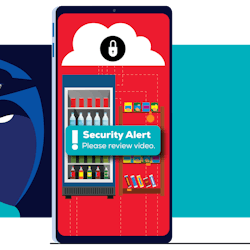Southern Refreshment Services Inc., a vending operation based in Tucker, Ga., recently identified the source of $8,000 in cash losses following an extensive internal investigation by my company, Loss Prevention Results Inc. in Wake Forest, N.C. Through the course of the investigation, a company technician was formally interrogated by myself and company co-owner Dan Hart. The technician was terminated for violation of company work rules.
An individual who had worked for seven vending companies in the greater Atlanta area, and who was a former co-worker of the terminated technician at another vending company, was caught on covert video stealing $37 from a machine using a key. In spite of police apathy, even in the face of indisputable video evidence against the individual (who was on probation for theft from stealing from another vending company with 10 arrests on his rap sheet), Hart pursued successful criminal charges.
Following is a question and answer session between myself and Hart.
Manney: Dan, this is a fascinating case covering elements across a wide spectrum of industry theft problems and solutions; high dollar cash theft, key control, public machine rip offs, covert camera investigations, time theft, GPS investigation, background investigations, interrogations based on evidence, case jacket documentation, police indifference, owner persistence, court room drama, and eventually, justice! Explain what happened, starting at the beginning.
Hart: At the end of August, we purchased the local operation of another company. For us, it was a huge acquisition/merger of 17 routes. We have never bitten off this much before. You lose focus on your normal day-to-day operations just trying to absorb this many new people into your process, into your building, into your culture. It was daunting. As we went through the process in September and October, large unexplained shortages hit us right from the beginning.
Manney: Cash shortages?
Hart: Serious cash shortages. This type of cash loss is highly unusual for our operation, so we immediately started changing locks. That slowed it down, but it didn’t stop. These were all brand new expensive locks that we purchased. Then the cash losses reared back up and we spent another $10,000 on more brand new locks.
To be safe, we further narrowed down the master key situation. We also made sure that the route people only had one key to their route, and still the shortages continued. We placed three VendingCams we already had out, trying to find out what was going on, and we also got our new route drivers on handhelds to track product and cash movement.
Manney: When were the new employees put on handhelds?
Hart: As quickly as we could, but it takes time and concentrated focus to put 17 route drivers on a handheld for the first time, all at once. We also focused on two large public accounts that we were having the most losses at, accounts where anyone could walk in with access to the machines.
Manney: What type of businesses were they?
Hart: One was a hospital and the other one was a university. We put out our three VendingCams, but didn’t get a hit. That’s when I called you back in and bought several of the new VendingCam IIs, scattering them back out as well. Then the law of averages kicked in. We videotaped a guy on a Saturday at 7 a.m. stealing $37. The video was crystal clear, but we had no idea of who he was.
Manney: And he had keys to the machine?
Hart: That was the strange part; the lock on the machine he opened with a key was changed one week prior to the videotaped theft. Again, taking the old key from the route driver, bringing it back in here, total key control on the new keys, giving another master key to the service technician, verifying that we had control of all of our master keys. In the video, the thief walks up, has two keys in his hands on a regular ring, puts one in the machine, opens it up, and helps himself to all the dollar bills.
Manney: How much were your total losses since the acquisition? And how did you identify the thief in the video?
Hart: At this point, cash losses were at about $8,000 in a period of two months, and we had no idea who this guy was! Then, because of the camera, we discovered he was an old employee from the company we had acquired.
The camera allows you to print down any single frame. That can be a significant capability. We had a dozen clear full frontal face shots of him, printed them out and fanned out showing our home-made mug shots to people we trusted. This immediately brought a hit.
One lead led to another, and eventually we discovered he had worked for a total of seven vending companies in the greater Atlanta area. But my question was, how was he getting our brand new keys?
We checked with the lock company, and only three people in the country could make key copies, and no one had but us. In trying to answer the key question, we re-verified everyone who had master keys. That’s when we discovered there was one tech we had missed earlier. One tech who didn’t have his two master keys on a distinctive locking key ring, and one of his keys opened the machine that the guy on the video had stolen the cash from. You could see on the video that the key this guy used wasn’t on a locking key ring.
You had also helped at that time with the criminal background check, and we knew the guy on the video had a long criminal record, and was even on probation for stealing from another vending company when he stole from us.
Manney: Explain how the investigation moved forward on the technician.
Hart: Once we realized the tech’s key had to be the one used by the guy on the video, we put covert GPS on the tech’s truck. The GPS immediately documented erratic, unacceptable behavior. Places the tech had no business being at, accounts that he was supposed to be at that he never showed up to, late starting times and early quitting times, even suspected personal errands with our vehicle and fuel.
We wrote him up without telling him about the covert GPS, using a plausible reason, and made sure we had documented all the work rules with him. Then there was another GPS time incident, and you came in for the audiotaped interrogation with me as the witness.
Manney: Explain what came out of that audiotaped confrontation, with his permission on tape, me sitting directly across from him, and you as the witness.
Hart: Well, in a word, it was intense. I have read the transcript you provided a couple of times. He said a number of things I didn’t believe, and other things I was surprised he said and even admitted. On the theft issue, he identified the individual we had on our mug shots stealing the cash as a former co-worker and a present friend who he hung around with.
We knew that from others, but still, it came right from him. He gave us some interesting personal information on the suspect. He also stated that when they worked together at the company we acquired, the suspect had approached him about borrowing his keys to steal from machines. He said he wouldn’t go along with him. I didn’t believe him, and you hammered him on it.
Finally, when cornered, he said he always left his keys in the truck over the weekend, and maybe someone was breaking into his truck, using his keys, and putting them back before Monday, all without his knowledge. That was a fairy tale, and I think a panicked attempt at an alibi.
I terminated him for violating our work rules. You and I walked him out during the peak return time and watched him clean out our van.
Manney: I thought you rattled him hard at the end yourself. He didn’t admit involvement, but that whole bit about maybe someone was stealing his keys over the weekend and putting them back on Monday was ludicrous. In my mind, he had already shoved his buddy overboard.
It wasn’t what he said, but the way he said it. This may not be over for him yet, as court room plea bargains have been known to pave the way for unexpected endings. There is an old truism: there is no honor among thieves. We will see how this plays out.
Hart: You and I took the case jacket to the police, filed charges, and met with the sergeant of detectives. He was enthusiastic about the case and told me he would turn it over to one of his detectives.
Then nothing happened. As time went on, I pressed the detective assigned to the case on the phone, but he said it was only a misdemeanor, and if I wanted to have the suspect arrested, even with this detective knowing his long police record and seeing the video, he said I would have to go to magistrate court and file out a warrant for his arrest myself.
I told him this wasn’t a misdemeanor to me; I had $8,000 missing just in cash, not counting locks, and two or three times that amount in time. With the losses, I felt it was necessary to pursue this to the end. Plus, I believe in zero tolerance for theft, no matter how much it is. I also wanted to make a strong statement to everyone.
I went to magistrate court, met with the judge, filed a warrant for his arrest, and they gave me a hearing. In magistrate court, you have to present your evidence and the person you file against has a chance to give their side of the story, then the judge makes the decision whether a warrant should be sworn for their arrest or not. With the video evidence and the case jacket I felt more than ready.
Manney: What happened in court?
Hart: When it was my turn. the judge, a no-nonsense Judge Judy type of woman, asked me what evidence I had. When I told her I had hidden, motion-activated video cameras inside my vending machines that showed exactly who was in the machines, with a date time stamp showing exactly what they did, when they were in the machine, and I had a video of the accused stealing cash out of one of my machines, she snapped her head, staring hard at me and said, “You have video cameras inside your vending machines?” You could hear a pin drop in the courtroom. Then I said, “Yes ma’am, I do.” I told her I had a bunch of cameras that I use for surveillance on these types of situations.
I told her I also had a case jacket that documented and proved the exact loss, to the dollar, and I had a CD with the video of the actual theft pointing at the suspect, and said: “Of him stealing money out of my machine.”
I had to clarify the fact that I had never seen the suspect before we walked into the court room, and that he had never worked for me. She had a hard time understanding how he was able to get into my vending machine, because he didn’t work for me and didn’t have a key.
Then I played the video, in slow motion, of the suspect using a key to open our machine in a hospital on a Saturday morning, look around pulling out a thick wad of cash, stuffing it into his pocket, then close and lock the machine. It is a crystal clear video.
The judge glared at the defendant and said in a loud, stern voice, “Sir, this is irrefutable evidence of your guilt!” Then she added two additional charges, breaking and entering and criminal trespassing.
He had no idea of the evidence I had. He was standing right there in the court room wearing a shirt with the logo of another vending company. Before I showed the video, he tried to stare me down as we were waiting for his case to be called. After the judge got finished, he was done and he knew it.
Manney: Excuse the pun, but you are a man after my own heart! I love courtroom stares from bad guys; they always provide the opposite intended effect. How did the courtroom confrontation end?
Hart: The judge had a discussion with him; he was given a couple of options. He said he would take the arrest warrant and turn himself in the next day. We are now waiting on a court hearing on that arrest warrant for his sentence and to bring this investigation to a close. My cash losses had dropped to where they use to be, rare and minor.
Manney: What about the suspect’s criminal background that was uncovered after he was identified through the video?
Hart: I’d asked you to conduct a criminal background on him, and that showed he had 10 warrants and 10 arrests and 10 convictions for theft on his record.
One was from another vending company in this area that he had worked for and had stolen a lot of money from. A small operator, but fortunately, one time he chose to steal from machines in a break room where the operator’s client had a video camera, and they were able to prove he was responsible for the theft.
When he was arrested for that crime, he was on probation for other crimes. He served time for that. This conviction will violate his present probation and could send him back to jail for a long time.
Manney: Ten arrests! What kind of time is he looking at?
Hart: The judge’s comment was up to 10 years, but it’s all evidentially based on what the probation officer does. She didn’t paint a pretty picture for him. I think he is going to get serious time for arrest number eleven. Hopefully, this will remove him from the vending industry in the Atlanta market, as he has been a real menace.
Manney: Dan, as I said earlier, this case holds all the elements: high dollar cash theft-key control, public machine rip offs, covert camera investigations, time theft — GPS investigation, background investigations, interrogation, case jacket documentation, police indifference, owner persistence, court room drama, and evidently a career vending criminal who is facing a severe penalty for stealing. When is this individual’s next court appearance from the arrest warrant?
Hart: The district attorney just sent me a notice, April 1.




